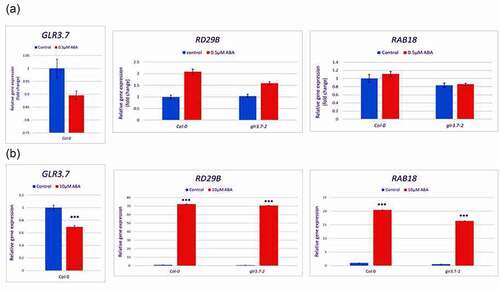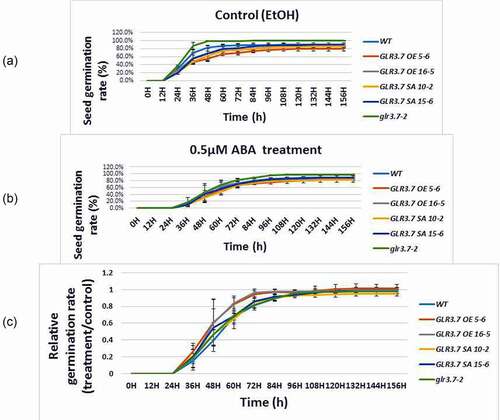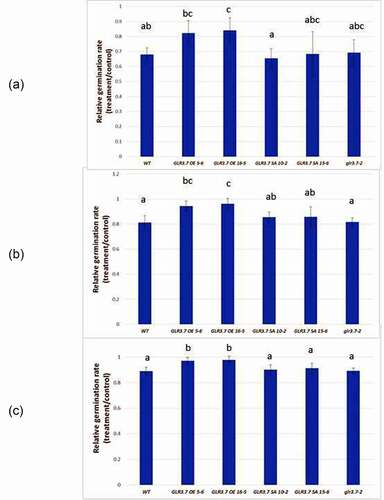ABSTRACT
The ionotropic glutamate receptor (iGluR) plays an important role in neuronal signaling in animal cells. There are at least 20 glutamate receptor-like (GLR) genes in Arabidopsis thaliana. These genes are involved in seed germination, root growth, wounding response, stomata closure, etc. A recent study showed that Arabidopsis clade III glutamate receptor GLR3.7 is involved in salt stress response. We tested whether GLR3.7 is involved in abscisic acid (ABA) response. In the present study, we found that the expression of GLR3.7 was reduced by ABA treatment. Under ABA-treated condition, GLR3.7 overexpression lines exhibited significantly higher seed germination rate at 60, 72 and 84 h under ABA-treated condition. A point mutation in 14-3-3 binding site of GLR3.7 in GLR3.7-S860A overexpression lines exhibited higher seed germination inhibition under ABA-treated conditions. Our results support that GLR3.7 is involved in ABA response in Arabidopsis. In addition, Ser-860 of GLR3.7 appears to be important in ABA response.
In the Arabidopsis genome, there are various genes encoding ion channels including aquaporins.Citation1,Citation2 To maintain calcium concentration in the cytoplasm, the calcium transporters maintain dynamic equilibrium to calcium ions. Glutamate receptor-like channels (GLRs) are known as calcium-permeable channels.Citation3 In mammals, glutamate receptors iGLuRs play essential roles in cell-to-cell communication in the nervous system.
Plant GLRs are known in regulating salt stress response. GLR3.4 was found to be involved in seed germination under salt stress conditionsCitation4 in Arabidopsis. A recent study showed that Arabidopsis clade III glutamate receptor GLR3.7 is involved in seed germination under salt stress condition.Citation5 Mutant line glr3.7–2 reduced cytosolic calcium level by salt stress. In addition, point-mutation of 14-3-3 binding site of GLR3.7 to alanine (GLR3.7-S860A) reduced root growth inhibition by salt stress.Citation5
Under ABA-treated conditions, seed germination is inhibited and cotyledon greening is reduced. It was reported that GLR1.1-deficient mutant increased ABA sensitivityCitation6 in Arabidopsis. Overexpression of GLR3.5 reduced ABA sensitivity and seed germinated earlier in Arabidopsis.Citation7 In the present study, we hypothesized and tested whether GLR3.7 is involved in abscisic acid (ABA)-mediated seed germination in Arabidopsis. To investigate whether gene expression of GLR3.7 is regulated by ABA, quantitative RT-PCR (qRT-PCR) was used to analyze GLR3.7 gene expression in wild-type Col-0. The expression level of GLR3.7 is lower under 0.5 μM and 10 μM ABA-treated condition (). The ABA response marker genes, RAB18 and RD29B, were up-regulated under 0.5 μM and 10 μM ABA-treated condition, which indicates the ABA treatment worked (). These results indicated that GLR3.7 expression is negatively regulated by the ABA in Arabidopsis.
Figure 1. GLR3.7 gene expression under ABA treatment. Seedlings of five-day-old wild-type were grown on ½ MS medium, and then treated with ABA or Ethanol (EtOH) for 2 hours before RNA extraction. (a) Expression level of GLR3.7, RD29B and RAB18 treated with 100% EtOH (control) and 0.5 μM ABA. (b) Expression level of GLR3.7, RD29B and RAB18 treated with 100% EtOH (control) and 10 μM ABA. RAB18 and RD29B are ABA-related marker genes. Gene expression level of UBQ10 was used as an internal control. These results indicated that GLR3.7 might be negatively regulated in ABA stress response. Each bar indicates mean ± SD in three biological replicates (N≧3, n≧9). Asterisks (*) indicate significant different compared with EtOH (control) (*p < 0.05, **p < 0.01, ***p < 0.001; Student’s t-test).

To study if GLR3.7 is involved in the ABA response, T-DNA insertion mutant glr3.7–25 was introduced. In addition, GLR3.7 overexpression lines OE5-6, OE16-5 and phosphorylation site point-mutation lines SA10-2, SA15-65 (Supplemental ) were also introduced. These lines were subjected to 0.5 μM ABA treatment for seed germination assay. Our results showed that OE5-6, OE16-5 exhibited significantly higher seed germination rate at 60 h (), 72 h () and 84 h () (Supplemental table 1). By contrast, GLR3.7-S860A overexpression lines 10–2 and 15–65 exhibited higher seed germination inhibition under ABA-treated conditions with significant difference from OE5-6 and OE16-5 at 72 h () and 84 h ()(Supplemental table 1), but did not show significant difference from the wild type and glr3.7–2. These indicate that GLR3.7 is involved in the ABA response in Arabidopsis.
Figure 2. Seed germination of the GLR3.7 overexpression lines are less sensitive to ABA than that of Col-0. Seeds of both lines were plated on half-strength MS medium containing (a) 100% EtOH (control) or (b) 0.5 μM ABA for seed germination. Germination rate was observed every 12 h. (c) Quantitative statistical analysis of seed germination rate: germination rate in the ABA-treated group divided by the germination rate in the control group. The results were statistically analyzed by Student t test (mean ± SD, N = 3, total n ≥ 600, *P < 0.05).

Figure 3. Relative seed germination rate of the GLR3.7 overexpression lines are less sensitive to ABA than that of Col-0 and GLR3.7-S860A overexpression lines in ABA-treated (a) 60, (b) 72, (c) 84 hours. Seeds of both lines were plated on half-strength MS medium containing 100% EtOH (control) or 0.5 μM ABA for seed germination. Quantitative statistical analysis of seed germination rate: germination rate in the ABA-treated group divided by the germination rate in the control group. The results were statistically analyzed by one-way ANOVA with post hoc Tukey honestly significant difference test (significantly at P < .05). (mean ± SD, N = 3, total n ≥ 600, significantly at P < 0.05).

GLR3.4 was found to be involved in seed germination under salt stress conditionsCitation4 in Arabidopsis. glr3.4 mutation line exhibited higher germination sensitivity under 150 mM NaCl treatment, by delaying germination time, than the wild type.Citation4 In Cheng’s study, they found that GLR3.4 is involved in ABA-mediated seed germination.Citation4 In the present study, we also found that GLR3.7 is involved in ABA-mediated seed germination. It appeared that GLR3.4 and GLR3.7 can have functional redundancy. It will be interesting to cross glr3.4 and glr3.7 mutants to generate glr3.4 glr3.7 double mutant and test for salt and ABA responses to confirm the functional redundancy issue. Moreover, in our previous study, we found that GLR3.7-S860A overexpression lines 10–2 and 15–6 exhibited lower sensitivity of primary root growth inhibition to salt stress.Citation5 In the present study, we found that GLR3.7-S860A overexpression lines 10–2 and 15–6 exhibited higher seed germination inhibition under ABA-treated conditions, which suggests that the 14-3-3 binding site Ser-860 is important in the ABA response in Arabidopsis.
Supplemental Material
Download Zip (59.2 KB)Acknowledgments
We thank Ministry of Science and Technology, Taiwan (109-2313-B-002-020, 109-2311-B-002-028, 110-2311-B-002-028) for funding support.
Disclosure statement
No potential conflict of interest was reported by the author(s).
Supplementary material
Supplemental data for this article can be accessed on the publisher’s website
Additional information
Funding
References
- Pantoja O. Recent advances in the physiology of ion channels in plants. Annu Rev Plant Biol. PMID: 33428476. 2021;72(1):1–4. doi:https://doi.org/10.1146/annurev-arplant-081519-035925.
- Tyerman SD, McGaughey SA, Qiu J, Yool AJ, Byrt CS. Adaptable and multifunctional ion-conducting aquaporins. Annu Rev Plant Biol. 2021;72(1):703–736. doi:https://doi.org/10.1146/annurev-arplant-081720-013608.
- Kudla J, Batistic O, Hashimoto K. Calcium signals: the lead currency of plant information processing. Plant Cell. 2010;22:541–563. PMID: 20354197. https://academic.oup.com/plcell/article/22/3/541/6096687
- Cheng Y, Zhang X, Sun T, Tian Q, Zhang WH. Glutamate receptor homolog3.4 is involved in regulation of seed germination under salt stress in Arabidopsis. Plant Cell Physiol. 2018;59:978–988. PMID: 29432559. https://academic.oup.com/pcp/article/59/5/978/4844071
- Wang PH, Lee CE, Lin YS, Lee MH, Chen PY, Chang HC, Chang IF. The glutamate receptor-like protein GLR3.7 interacts with 14-3-3ω and participates in salt stress response in Arabidopsis thaliana. Front Plant Sci. 2019;10:1169. PMID: 31632419. https://www.frontiersin.org/articles/https://doi.org/10.3389/fpls.2019.01169/full
- Kang J, Mehta S, Turano FJ. The putative glutamate receptor 1.1 (AtGLR1.1) in Arabidopsis thaliana regulates abscisic acid biosynthesis and signaling to control development and water loss. Plant Cell Physiol. PMID: 15564521. 2004;45(10):1380–1389. doi:https://doi.org/10.1093/pcp/pch159.
- Kong D, Ju C, Parihar A, Kim S, Cho D, Kwak JM. Arabidopsis glutamate receptor homolog3.5 modulates cytosolic Ca2+ level to counteract effect of abscisic acid in seed germination. Plant Physiol. PMID: 25681329. 2015;167(4):1630–1642. doi:https://doi.org/10.1104/pp.114.251298.
